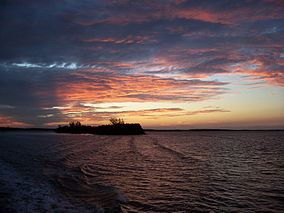Biscayne National Park
| Biscayne National Park | |
|---|---|
|
IUCN category II (national park)
|
|

Sunset at Biscayne National Park
|
|
| Location | Miami-Dade County, Florida, United States |
| Nearest city | Homestead |
| Coordinates | 25°28′10″N 80°11′10″W / 25.46944°N 80.18611°WCoordinates: 25°28′10″N 80°11′10″W / 25.46944°N 80.18611°W |
| Area | 172,971 acres (699.99 km2) |
| Established | June 28, 1980 |
| Visitors | 514,709 (in 2016) |
| Governing body | National Park Service |
| Website | Biscayne National Park |
Biscayne National Park is a U.S. National Park located in southern Florida, south of Miami. The park preserves Biscayne Bay and its offshore barrier reefs. Ninety-five percent of the park is water, and the shore of the bay is the location of an extensive mangrove forest. The park covers 172,971 acres (69,999 ha) and includes Elliott Key, the park's largest island and first of the true Florida Keys, formed from fossilized coral reef. The islands farther north in the park are transitional islands of coral and sand. The offshore portion of the park includes the northernmost region of the Florida Reef, one of the largest coral reefs in the world.
Biscayne National Park protects four distinct ecosystems: the shoreline mangrove swamp, the shallow waters of Biscayne Bay, the coral limestone keys and the offshore Florida Reef. The shoreline swamps of the mainland and island margins provide a nursery for larval and juvenile fish, molluscs and crustaceans. The bay waters harbor immature and adult fish, seagrass beds, sponges, soft corals, and manatees. The keys are covered with tropical vegetation including endangered cacti and palms, and their beaches provide nesting grounds for endangered sea turtles. Offshore reefs and waters harbor more than 200 species of fish, pelagic birds, whales and hard corals. Sixteen endangered species including Schaus' swallowtail butterflies, smalltooth sawfish, manatees, and green and hawksbill sea turtles may be observed in the park. Biscayne also has a small population of threatened American crocodiles and a few American alligators.
The people of the Glades culture inhabited the Biscayne Bay region as early as 10,000 years ago before rising sea levels filled the bay. The Tequesta people occupied the islands and shoreline from about 4,000 years before the present to the 16th century, when the Spanish took possession of Florida. Reefs claimed ships from Spanish times through the 20th century, with more than 40 documented wrecks within the park's boundaries. While the park's islands were farmed during the 19th and early 20th centuries, their rocky soil and periodic hurricanes made agriculture difficult to sustain. In the early 20th century the islands became secluded destinations for wealthy Miamians who built getaway homes and social clubs. Mark C. Honeywell's guesthouse on Boca Chita Key was the area's most elaborate private retreat, featuring a mock lighthouse. The Cocolobo Cay Club was at various times owned by Miami developer Carl G. Fisher, yachtsman Garfield Wood, and President Richard Nixon's friend Bebe Rebozo, and was visited by four United States presidents. The amphibious community of Stiltsville was established in the 1930s in the shoals of northern Biscayne Bay, taking advantage of its remoteness from land to offer offshore gambling and alcohol during Prohibition. Following the Cuban Revolution of 1959, Elliott Key was used as a training ground for infiltrators into Fidel Castro's Cuba by the Central Intelligence Agency and by Cuban exile groups.
...
Wikipedia

